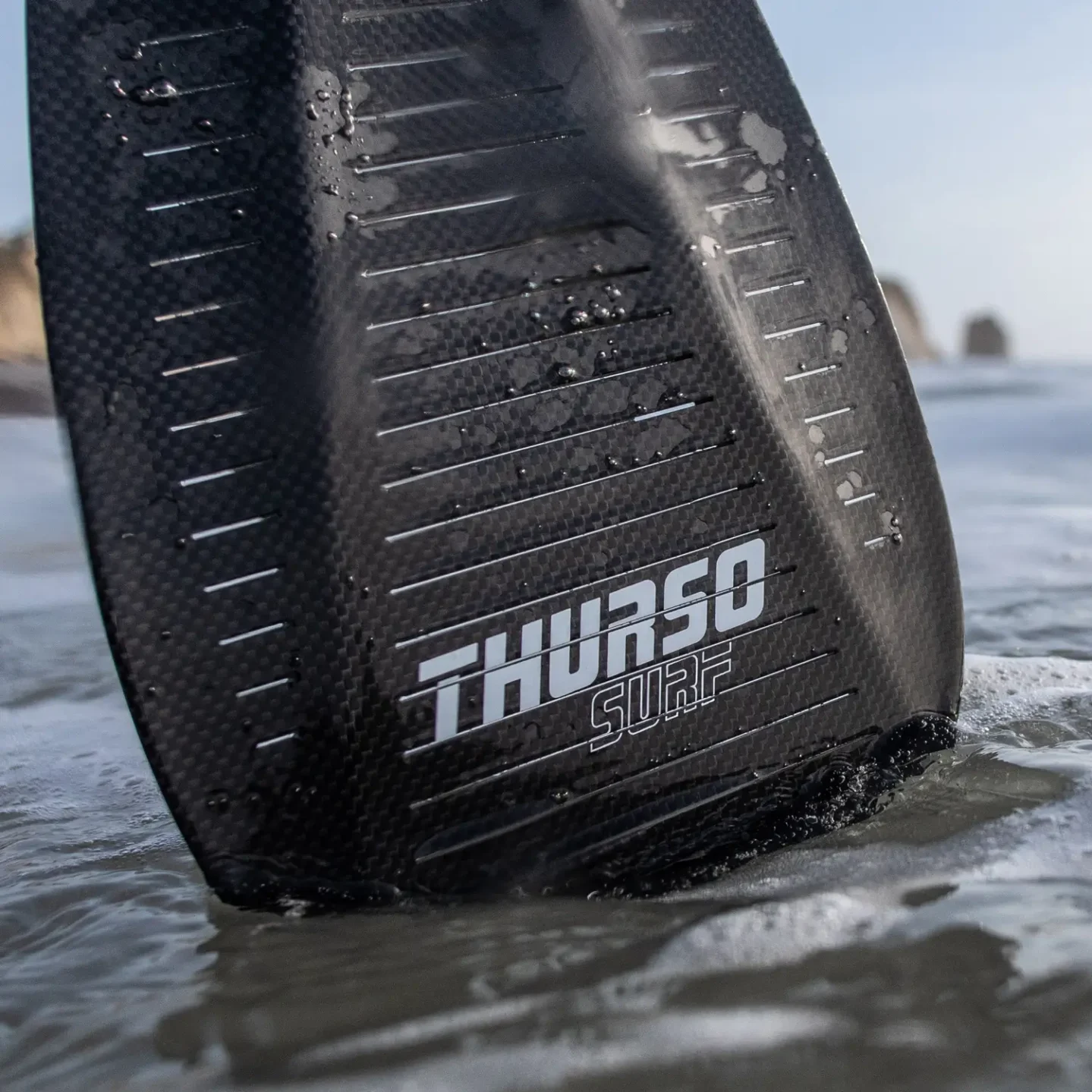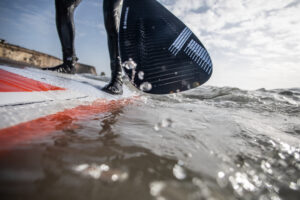Summary: In a recent field test at Action Water Sports Lake, we compared the performance of the Thurso Surf 3-part carbon fiber paddle with its blade slots covered versus uncovered. Conducted over a series of upwind and downwind sprints, the test revealed subtle but important advantages when the paddle’s slots were exposed, reducing the number of strokes required over 140m and 600m distances. Notably, even when fatigued, the paddle allowed for more distance per stroke, potentially reducing 300 strokes over a long-distance race. Although speed differences were minimal, the uncovered slotted paddle provided a more efficient, easier paddling experience, making it a valuable option for paddlers seeking to maintain endurance and efficiency over long distances. As Steve West pointed out in a previous article “the slotted paddles do not claim to make you go faster but what can be said is it will keep you fast for longer which translates into greater distances travelled at a higher average speed.”
Thurso Surf 3 part carbon fibre slotted paddle
Location: Action Water Sports Lake, Kent 02/10/24
All runs 140m and 600m were between fixed markers on the waterski lake.
Wind speed 10-15 mph across the lake, at an angle giving slight upwind and downwind runs. The wind was fairly constant throughout the test and I used the sheltered side of the lake to paddle on, still no “mill pond conditions” yet.
I calculated the blade area of the Thurso Surf blade to be 84sq inches. I tried the paddle initially with the slots covered (taped over)
10 x 140m runs upwind and downwind.
2 x 600 m runs upwind and downwind.
Then I removed the tape slots uncovered and repeated the above runs 10 x 140m runs upwind and downwind.
2 x 600m runs upwind and downwind.
At the end of every individual run I stopped and wrote down the results.
Blade slots covered Blade slots uncovered
Timed 140m runs UPWIND Timed 140m runs UPWIND
——————————— ———————————
45 paddle strokes, time 1 min 08 45 paddle strokes, time 1 min 05
47 paddle strokes, time 1 min 02 44 paddle strokes, time 1 min 02
46 paddle strokes, time 1 min 02 46 paddle strokes, time 1 min 02
46 paddle strokes, time 1 min 02 45 paddle strokes, time 1 min 02
46 paddle strokes, time 1 min 03 45 paddle strokes, time 1 min 02
Blade slots covered Blade slots uncovered
Timed 140m runs. DOWNWIND Timed 140m runs DOWNWIND
——————————— ———————————
43 paddle strokes, time 1 min 04 46 paddle strokes, time 1 min 02
45 paddle strokes, time 1 min 07 45 paddle strokes, time 1 min 01
45 paddle strokes, time 1 min 02 44 paddle strokes, time 1 min 02
45 paddle strokes, time 1 min 02 44 paddle strokes, time 1 min 02
45 paddle strokes, time 1 min 02 44 paddle strokes, time 1 min 02
Blade slots covered Blade slots uncovered
Timed 600m run DOWNWIND Timed 600m run DOWNWIND
———————————— ———————————
193 paddle strokes, time 4 min 25 185 paddle strokes, time 4 min 24
Blade slots covered Blade slots uncovered
Timed 600m run UPWIND Timed 600m run UPWIND
—————————— ———————————
192 paddle strokes, time 4 min 42 185 paddle strokes, time 4 min 45
For comparison using an 85sq inch ZRE fixed length paddle
Timed runs over 140m
——————————
Downwind 45 paddle strokes, time 1 min
Upwind 45 paddle strokes, time 1 min
I have laid out the data above in upwind slots covered and uncovered
and downwind slots covered and uncovered for ease at looking at the data.
What the data does not show is all the runs with the slots covered were carried out first for the 10 x 140m runs and the 2 x 600m runs. I then removed the tape to uncover the slots and then carried out the 10 x 140m runs and the 2 x 600m runs.
Things to note
———————
(1) All runs were carried out at max paddling pace with 1 minute breaks in between.
(2) As per the East of England slotted blade when I removed the tape I did feel instantly a step change as the paddle was easier to paddle with less effort.
(3) As I could not keep taking the tape off and reapplying, all the covered runs were done first then uncovered runs were done when I was starting to feel tired.
Conclusions
——————-
I surprised myself at how consistent my paddling was over the 140m sprints only a couple of seconds and one or two strokes different each time and the same time over the 600m distance with only 3 seconds difference!
It can be seen there is a marginal gain on the 140m runs with the slots uncovered.
This marginal gain was amplified on the 600m run from 192/193 strokes down to 185/185 when slots were uncovered for almost identical paddling times.
Over a long distance race such as Hayling Island would result in a reduction of 300
paddle strokes. This shows more distance per stroke, which is interesting as I would have thought the easier paddle would have had a higher cadence not a lower one.
It obviously shows the paddle concept is efficient at 3.24m/stroke uncovered to 3.1m/ stroke covered.
Again, all the results with the slots uncovered were done at the end when I was starting to tire, so reversing the process might have shown further gains.
As per Steve West’s comments on “splash” with this paddle I did notice a hint of a splash on entry. This was confirmed when afterwards I used my ZRE paddle which is silky smooth and silent on entry.
One final piece of data at the end of each block of runs I had a max speed in mph from my GT31. For the covered paddle max speed was 5.9 mph For the uncovered paddle max speed was 5.99 mph For the ZRE paddle max speed was 6.03 mph.
Again, as Steve West pointed out “the slotted paddles do not claim to make you go faster but what can be said is it will keep you fast for longer which translates into greater distances travelled at a higher average speed.”
Mark Rose – BSUPA paddle Board Instructor since 2014
Principle BSUPA Instructor 2020 -2023 The Varne Water Sports Club

